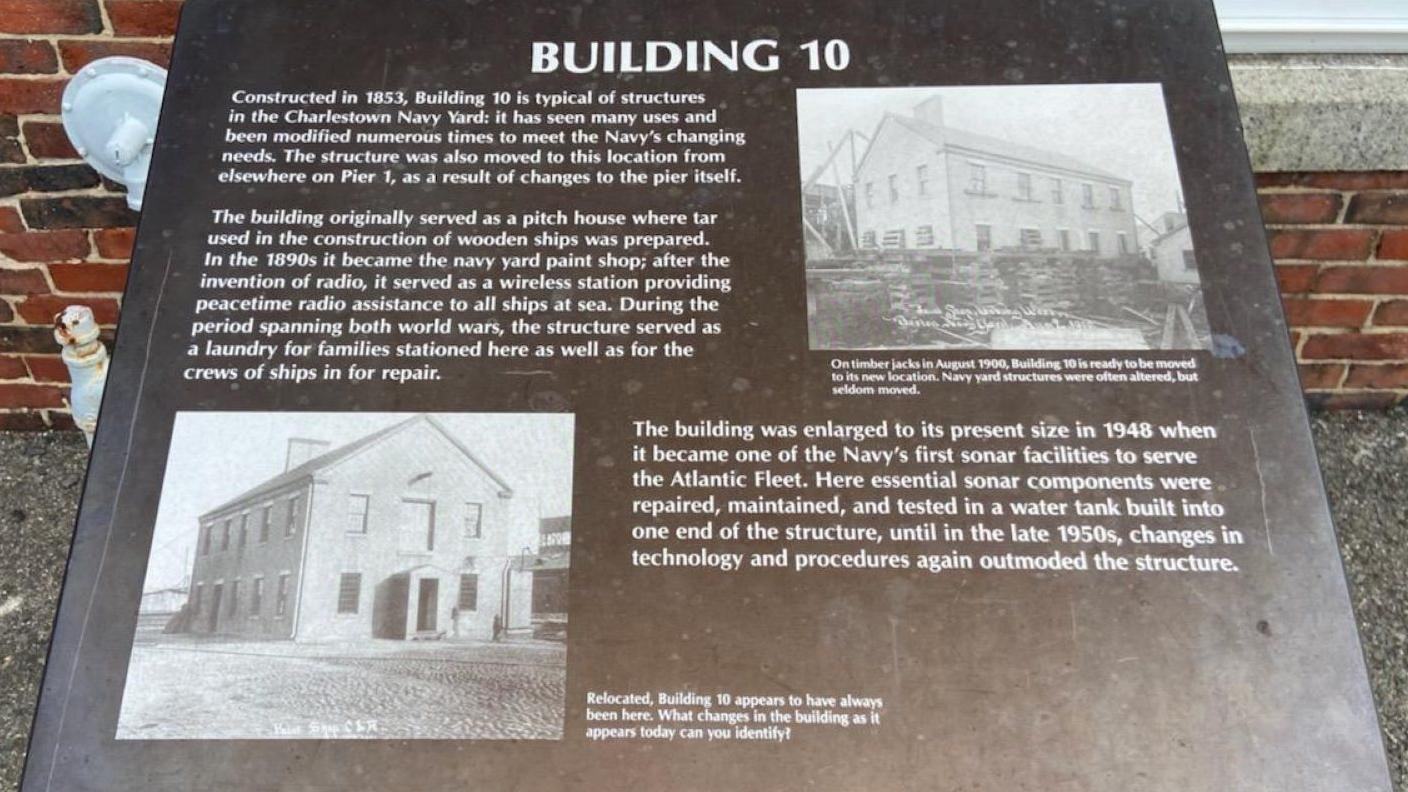Last updated: January 22, 2024
Place
"Building 10" Sign

NPS Photo/MWoods
Description
Low-profile wayside that is 30 X 24 inches. It has a semi-cylindrical base with two rectangular pillars supporting the panel. The panel is made from black metal. The sign is located on cement in front of Building 10, the old Shipyard Galley. The building sits across the pavement from where the USS Constitution is docked and is next to the portal crane.
Layout
The sign is black metal with white text and black and white images. Centered at the top is the sign’s title in uppercase letters. The text and images are arranged in two columns. The first column features the first two paragraphs of the main text separated by a space. A square photo is below the text. The image’s caption is to the right of the image’s bottom right corner. The second column features a square image with its caption centered below the image. Below the caption is the last paragraph of the main text.
Title
Building 10
Main Text
Constructed in 1853, Building 10 is typical of structures in the Charlestown Navy Yard: it has seen many uses and been modified numerous times to meet the Navy’s changing needs. The structure was also moved to this location from elsewhere on Pier 1, as a result of changes to the pier itself. The building originally served as a pitch house where tar used in the construction of wooden ships was prepared. In the 1890s it became the navy yard paint shop; after the invention of radio, it served it served as a wireless station providing peacetime radio assistance to all ships at sea. During the period spanning both world wars, the structure served as a laundry for families stationed here as well as for the crews of ships in for repair. The building was enlarged to its present size in 1948 when it became of the Navy’s first sonar facilities to serve the Atlantic Fleet. Here essential sonar components were repaired, maintained, and tested in a water tank built into one end of the structure, until in the late 1950s, changes in technology and procedures again outmoded the structure.
Image (first column)
In the foreground a cobblestone road extends from the left to the right of the image. Script is written along the bottom in the center that says, “Paint Shop C &R.” Building 10 rises in the mid-ground of the image. It is a two-story rectangular brick building with a gabled roof. The building sits at an angle, so its front and the side to the left are visible. On the facade, three windows line the second floor, with the middle window slightly larger than the other two. A beam with a rope dangling from it extends from the house above the larger window. On the first floor, there is a doorway extending out from the house with a window on either side of the door. Five windows are on the second floor along the side to the left of the building. Along the first floor are three windows, a door, and then one more window. A chimney stack rises from the backend of the house. In the background are navy yard buildings and a clear sky.
Image Caption
Relocated, Building 10 appears to have always been here. What changes in the building as it appears today can you identify?
Image (second column)
In the foreground, cut timber is stacked together in multiple towers. Slabs of wood are strewn over the dirt ground around the tower bases. Parts of two buildings are seen on the right side of the image. Two lines of script are centered along the bottom: Paint Shop, Looking West, Boston Navy Yard, Aug 2, 1900. A two-story rectangular building with a gabled roof sits atop the timber stacks. The building is angled so the back and the side to the left of the building are in view. The back of the building has three windows along each floor. The bottom windows have stacks of wood in front of them. On the building’s right side, five windows line the second floor. Four windows line the first floor. A stack of wood blocks are in front of a space that could be a window or door. A chimney stack rises from the building’s roof. In the background, wooden beams rise alongside the unseen side of the house. Other buildings are behind the beams.
Image Caption
On timber jacks in August 1900, Building 10 is ready to be moved to its new location. Navy yard structures were often altered, but seldom moved.
